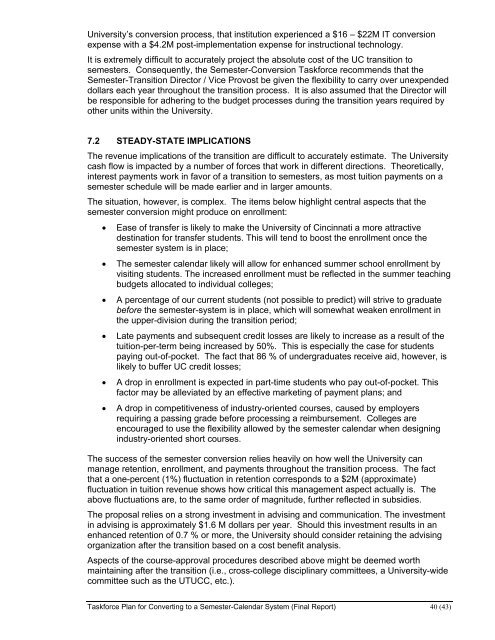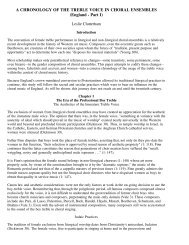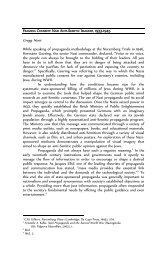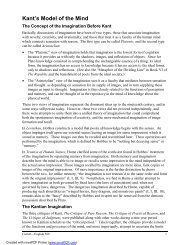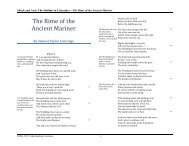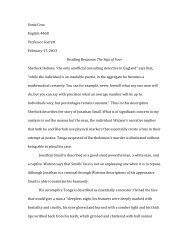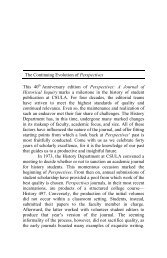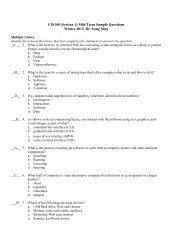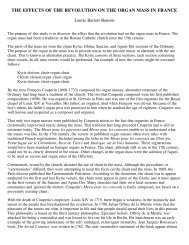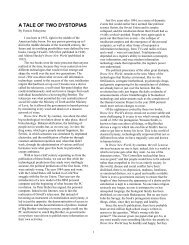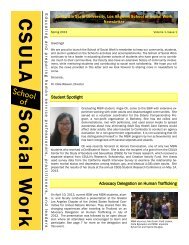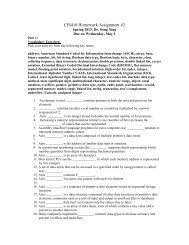Semester-Calendar System - California State University, Los Angeles
Semester-Calendar System - California State University, Los Angeles
Semester-Calendar System - California State University, Los Angeles
Create successful ePaper yourself
Turn your PDF publications into a flip-book with our unique Google optimized e-Paper software.
<strong>University</strong>’s conversion process, that institution experienced a $16 – $22M IT conversion<br />
expense with a $4.2M post-implementation expense for instructional technology.<br />
It is extremely difficult to accurately project the absolute cost of the UC transition to<br />
semesters. Consequently, the <strong>Semester</strong>-Conversion Taskforce recommends that the<br />
<strong>Semester</strong>-Transition Director / Vice Provost be given the flexibility to carry over unexpended<br />
dollars each year throughout the transition process. It is also assumed that the Director will<br />
be responsible for adhering to the budget processes during the transition years required by<br />
other units within the <strong>University</strong>.<br />
7.2 STEADY-STATE IMPLICATIONS<br />
The revenue implications of the transition are difficult to accurately estimate. The <strong>University</strong><br />
cash flow is impacted by a number of forces that work in different directions. Theoretically,<br />
interest payments work in favor of a transition to semesters, as most tuition payments on a<br />
semester schedule will be made earlier and in larger amounts.<br />
The situation, however, is complex. The items below highlight central aspects that the<br />
semester conversion might produce on enrollment:<br />
• Ease of transfer is likely to make the <strong>University</strong> of Cincinnati a more attractive<br />
destination for transfer students. This will tend to boost the enrollment once the<br />
semester system is in place;<br />
• The semester calendar likely will allow for enhanced summer school enrollment by<br />
visiting students. The increased enrollment must be reflected in the summer teaching<br />
budgets allocated to individual colleges;<br />
• A percentage of our current students (not possible to predict) will strive to graduate<br />
before the semester-system is in place, which will somewhat weaken enrollment in<br />
the upper-division during the transition period;<br />
• Late payments and subsequent credit losses are likely to increase as a result of the<br />
tuition-per-term being increased by 50%. This is especially the case for students<br />
paying out-of-pocket. The fact that 86 % of undergraduates receive aid, however, is<br />
likely to buffer UC credit losses;<br />
• A drop in enrollment is expected in part-time students who pay out-of-pocket. This<br />
factor may be alleviated by an effective marketing of payment plans; and<br />
• A drop in competitiveness of industry-oriented courses, caused by employers<br />
requiring a passing grade before processing a reimbursement. Colleges are<br />
encouraged to use the flexibility allowed by the semester calendar when designing<br />
industry-oriented short courses.<br />
The success of the semester conversion relies heavily on how well the <strong>University</strong> can<br />
manage retention, enrollment, and payments throughout the transition process. The fact<br />
that a one-percent (1%) fluctuation in retention corresponds to a $2M (approximate)<br />
fluctuation in tuition revenue shows how critical this management aspect actually is. The<br />
above fluctuations are, to the same order of magnitude, further reflected in subsidies.<br />
The proposal relies on a strong investment in advising and communication. The investment<br />
in advising is approximately $1.6 M dollars per year. Should this investment results in an<br />
enhanced retention of 0.7 % or more, the <strong>University</strong> should consider retaining the advising<br />
organization after the transition based on a cost benefit analysis.<br />
Aspects of the course-approval procedures described above might be deemed worth<br />
maintaining after the transition (i.e., cross-college disciplinary committees, a <strong>University</strong>-wide<br />
committee such as the UTUCC, etc.).<br />
Taskforce Plan for Converting to a <strong>Semester</strong>-<strong>Calendar</strong> <strong>System</strong> (Final Report) 40 (43)


